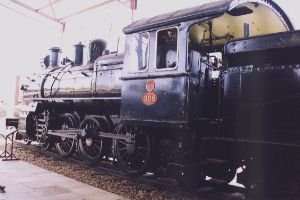E and Es Pacific Type Steam Locomotives
Es 308

| Builders: Nasmyth, Wilson & Co No 291-305 Vulcan Foundry No 306-335 North British Loco Co No 336-355 |
| Coupled wheel diameter 4' 6" |
| Total weight 83 tons 4cwt |
| Tractive effort 17,233 lbs |
| Coal capacity 5 tons |
| Water capacity 2200 gallons |
| Total number in service 65 |
The E class 4-6-2 locomotives were ordered in 1900 as a passenger locomotive for use on heavier lines. Their axle loading of 12.6 tons was just on the limit for 60lb rail. Fifteen locomotives were built by Nasmyth Wilson & Co while a further thirty locomotives were supplied by the Vulcan Foundry. Following erection of the locomotives at the Fremantle workshops during 1902 they were introduced into service between June and October 1903. They were initially placed in service on passenger duties on the Perth to Kalgoorlie passenger service as well as being allocated to the Kalgoorlie to Leonora line. The heavier hauling capacity lead to considerable savings in cost compared to the previous use R and O class locomotives.
Initially the class was plagued by several faults requiring rectification at Midland. Due to increasing traffic a further twenty locomotives were ordered from the North British Locomotive Company in 1911 and were placed in service during January and February 1912.
The E class remained as the principle express passenger locomotive on the WAGR until the arrival of the P and Pr classes in 1924 and 1938.
The class remained largely unchanged except for the conversion to superheated boilers. This work commenced in 1924 when an initial thirty two locomotives were converted. The remainder of the class apart from No 306 and 338 were converted by 1949. The modified locomotives were classified as Es. The first withdrawals were in 1945. Most of the class was withdrawn during the 1950's with the final locomotives being withdrawn in 1963. Es 308 entered service on 23 February, 1903 and was superheated on 23 May, 1925. Ten years later it was rebuilt with a new frame and was one of the last of the class in service. It was withdrawn from use on 7 October, 1963 after running 1¼ million miles (2 million km) and was stored till 3 June, 1972 when it was placed in the Rail Transport Museum.